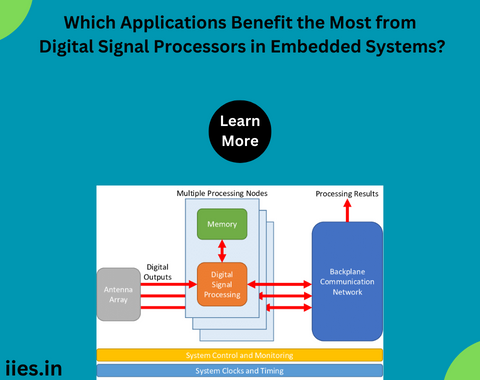
Embedded systems have become an integral part of our daily lives, powering a myriad of devices from washing machines and microwave ovens to sophisticated medical equipment and automotive control systems. These compact computing systems are designed to perform specific functions, often in real-time, making them essential in various industries. The success of embedded systems lies in their intricate architecture, which consists of several fundamental building blocks that work seamlessly together. In this article, we will delve into the key components that form the foundation of embedded systems.
At the heart of every embedded system lies a microcontroller or microprocessor, which serves as the brain of the system. Microcontrollers are preferred for embedded applications due to their integrated features, including a CPU (Central Processing Unit), memory, and various peripherals on a single chip.
Microprocessors, on the other hand, are more powerful and versatile but require external components to function. The choice between microcontroller and microprocessor depends on the specific requirements of the application.
Memory:
Memory is crucial for storing both program instructions and data in an embedded system. There are two main types of memory: RAM (Random Access Memory) and ROM (Read-Only Memory). RAM provides volatile storage for temporary data and variables during program execution, while ROM stores the firmware and essential program code. Flash memory, a type of non-volatile memory, is often used for storing the program and data persistently.
Peripherals:
Peripherals enhance the functionality of embedded systems by providing interfaces for communication with the external world. These include input devices like sensors and switches and output devices like LEDs and displays. Communication interfaces such as UART, SPI, I2C, and USB enable data exchange between the embedded system and external devices. The selection of peripherals depends on the application requirements, and their efficient integration is crucial for the system’s overall performance.
Timers and Counters:
Embedded systems often require precise timing for tasks such as generating pulses, measuring time intervals, or implementing real-time control. Timers and counters are essential building blocks that facilitate these functions. They help in managing tasks with specific time constraints and enable the system to respond in real-time to external events.
Interrupts:
Interrupts play a vital role in embedded systems by allowing the processor to respond promptly to external events without constantly monitoring them. When an interrupt occurs, the processor temporarily suspends its current task, executes the interrupt service routine, and then resumes the interrupted task. This mechanism is crucial for handling time-sensitive events and managing multiple tasks simultaneously.
Analog-to-Digital Converter (ADC) and Digital-to-Analog Converter (DAC):
Many embedded systems interact with the analog world through sensors and actuators. ADC converts analog signals, such as sensor readings, into digital data that the microcontroller can process. Conversely, DAC converts digital signals back into analog signals for controlling actuators. These components bridge the gap between the digital processing capabilities of the microcontroller and the analog nature of the physical world.
Power Management:
Efficient power management is essential for embedded systems, especially those designed for battery-powered or energy-efficient applications. Power management circuits, such as voltage regulators and low-power modes, ensure optimal energy consumption while maintaining the system’s functionality. This is crucial for extending the lifespan of battery-powered devices and reducing overall power consumption.
Real-Time Operating System (RTOS):
In applications where real-time performance is critical, an RTOS is employed to manage and schedule tasks with precise timing requirements. Unlike general-purpose operating systems, RTOS is designed to handle real-time constraints and ensure tasks are executed within specified deadlines. This is crucial in applications like medical devices, automotive control systems, and industrial automation, where timely responses are imperative.
Communication Interfaces:
Embedded systems often need to communicate with other devices or systems, and communication interfaces facilitate this exchange of information. Common communication interfaces include UART (Universal Asynchronous Receiver/Transmitter), SPI (Serial Peripheral Interface), I2C (Inter-Integrated Circuit), and USB (Universal Serial Bus). UART is frequently used for serial communication between devices, while SPI and I2C are employed for connecting multiple devices on the same bus. USB, a versatile interface, is prevalent in many embedded systems for data transfer and device connectivity.
Wireless Connectivity:
With the proliferation of IoT (Internet of Things) devices, wireless connectivity has become a crucial aspect of embedded systems. Components such as Wi-Fi and Bluetooth modules enable seamless communication with other devices and networks. These modules allow embedded systems to transmit and receive data wirelessly, expanding their capabilities and facilitating interconnected smart devices.
Security Features:
In an era where cybersecurity is of paramount importance, embedded systems must incorporate security features to protect against unauthorized access and data breaches. Secure boot mechanisms, encryption algorithms, and secure storage are vital components in ensuring the integrity and confidentiality of data within embedded systems. As these systems become more interconnected, robust security measures are essential to safeguard sensitive information.
Human-Machine Interface (HMI):
In applications where user interaction is necessary, the human-machine interface (HMI) plays a pivotal role. Displays, touchscreens, buttons, and other input/output devices constitute the HMI, allowing users to interact with the embedded system. The design of an effective HMI is crucial for user experience, and it often involves considerations such as responsiveness, clarity, and ease of use.
System Bus:
The system bus serves as the communication highway within the embedded system, connecting various components such as the CPU, memory, and peripherals.
Embedded systems form the backbone of countless devices that surround us in our daily lives. Understanding the building blocks of these systems is essential for engineers and developers involved in designing and implementing embedded solutions. From microcontrollers and memory to peripherals and real-time operating systems, each component plays a crucial role in shaping the functionality and performance of embedded systems. As technology advances, these building blocks continue to evolve, enabling the creation of more sophisticated and efficient embedded systems that power the innovations of the future.
Indian Institute of Embedded Systems – IIES